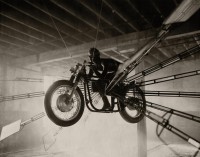BILL PHELPS
source: bikeexif
Brooklyn photographer Bill Phelps dropped us a line the other day, attaching some images that blew us away. They’re surreal, sensual, and often feature motorbikes. Bill’s style is unusual: sometimes there’s a dusty sepia look, and sometimes a hint of Victoriana. Often, there’s a heady, almost French Polynesian sexuality. I don’t know what camera Bill uses, but he sure knows his way around it. The bike in the picture, by the way, is a 1953 Norton Featherbed.
.
.
.
.
.
.
.
source: blogthe-impossible-project
For this installment of Artist in Residence, we check in with Bill Phelps, who shot our new Pioneer test version of the 8×10 Impossible film. His photos are on view in the Impossible Project NYC Space until September 24th, as part of the 8×10 by Impossible exhibition.
“I was very excited about the new 8 × 10 film, and very curious about it no longer being a peel apart process, it had become a completely new medium.
In seeing the work in the exhibition, I realized we were dealing with a new breed of film. After twenty years of shooting the Polaroid product, I had become very used it’s characteristics and sensitivities, rarely using a light meter. I approached this experiment in a rather methodical way, trying to create some constants, it showed itself to be very different from the original.
The first half of the box I shot in a white studio with only overcast, window light. The information I received from Impossible was very helpful, as was the tip sheet included in the package. Conditions and drying time are very important, Stefan Milev’s image with the leaves inside, took advantage of this, it was beautiful. I kept detailed notes, but I found rather quickly that I needed to remain open to whatever may come. That day showed me that it really was a different animal and I decided to shoot the rest of the film in a new situation.
I decided to shoot in my apartment under completely different light, setting up a still life backlit by a window, looking for shadow and contrast and reflection, simple form and modern edges. Shooting through glass on a mirrored surface, I had a whole new set of results compared to the studio experience. The blacks were warm and deep, the film holding more of a tonal range than I had seen the day before.
When shooting with the original Polaroid invention, some detail is lost, but it gains a beautiful depth, you could see the emulsion on the surface of the print. This film does not produce a print, but rather a layer of moving chemistry “captured” between layers. Milev’s intuition to explore this completely new space was wonderful to see. It is part photograph, part paint, part alchemy, part metallurgy, it’s very organic.
Working with the 8 × 10 camera again was so satisfying, and there is nothing like shooting instant film in combination with this tool, it “sees’ things so beautifully. I am really impressed with the focused passion of Impossible… I was honored to be a part of this project, and I think we have made a mark in the history of photography.”


